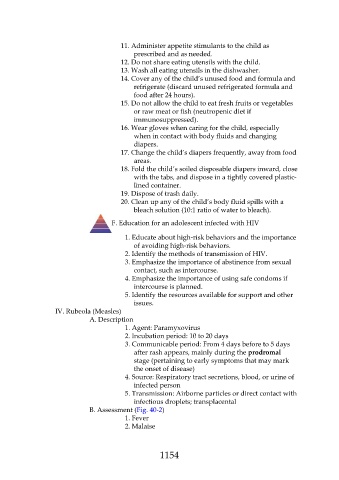Page 1154 - Saunders Comprehensive Review For NCLEX-RN
P. 1154
11. Administer appetite stimulants to the child as
prescribed and as needed.
12. Do not share eating utensils with the child.
13. Wash all eating utensils in the dishwasher.
14. Cover any of the child’s unused food and formula and
refrigerate (discard unused refrigerated formula and
food after 24 hours).
15. Do not allow the child to eat fresh fruits or vegetables
or raw meat or fish (neutropenic diet if
immunosuppressed).
16. Wear gloves when caring for the child, especially
when in contact with body fluids and changing
diapers.
17. Change the child’s diapers frequently, away from food
areas.
18. Fold the child’s soiled disposable diapers inward, close
with the tabs, and dispose in a tightly covered plastic-
lined container.
19. Dispose of trash daily.
20. Clean up any of the child’s body fluid spills with a
bleach solution (10:1 ratio of water to bleach).
F. Education for an adolescent infected with HIV
1. Educate about high-risk behaviors and the importance
of avoiding high-risk behaviors.
2. Identify the methods of transmission of HIV.
3. Emphasize the importance of abstinence from sexual
contact, such as intercourse.
4. Emphasize the importance of using safe condoms if
intercourse is planned.
5. Identify the resources available for support and other
issues.
IV. Rubeola (Measles)
A. Description
1. Agent: Paramyxovirus
2. Incubation period: 10 to 20 days
3. Communicable period: From 4 days before to 5 days
after rash appears, mainly during the prodromal
stage (pertaining to early symptoms that may mark
the onset of disease)
4. Source: Respiratory tract secretions, blood, or urine of
infected person
5. Transmission: Airborne particles or direct contact with
infectious droplets; transplacental
B. Assessment (Fig. 40-2)
1. Fever
2. Malaise
1154

